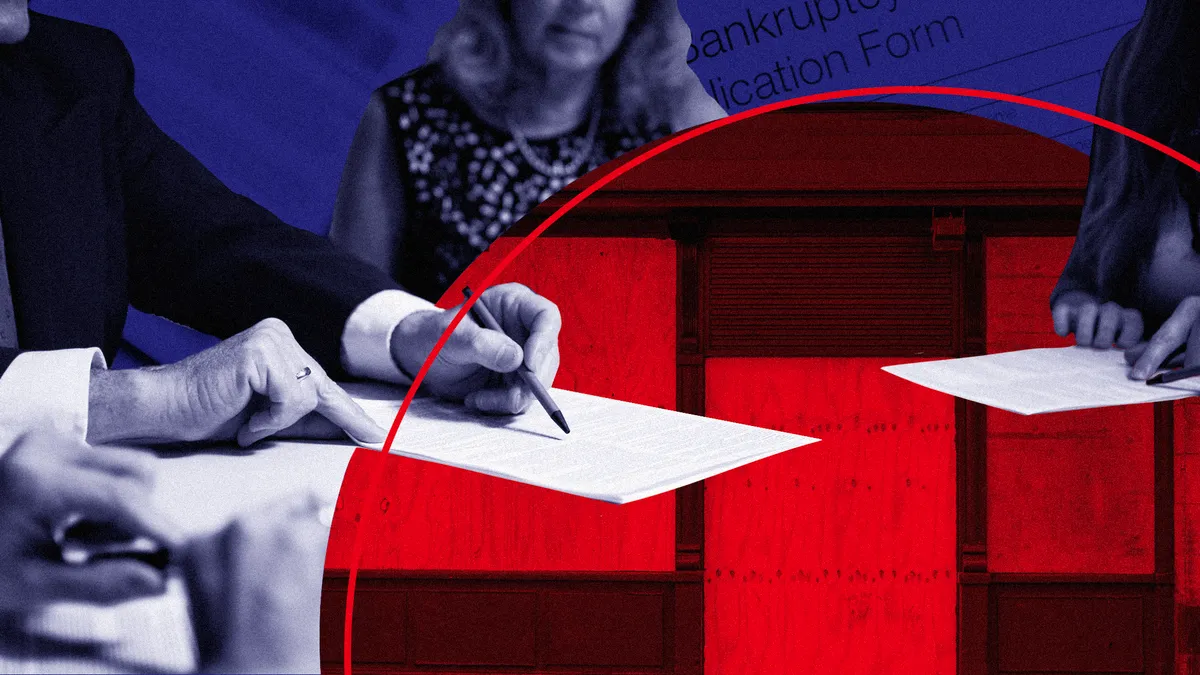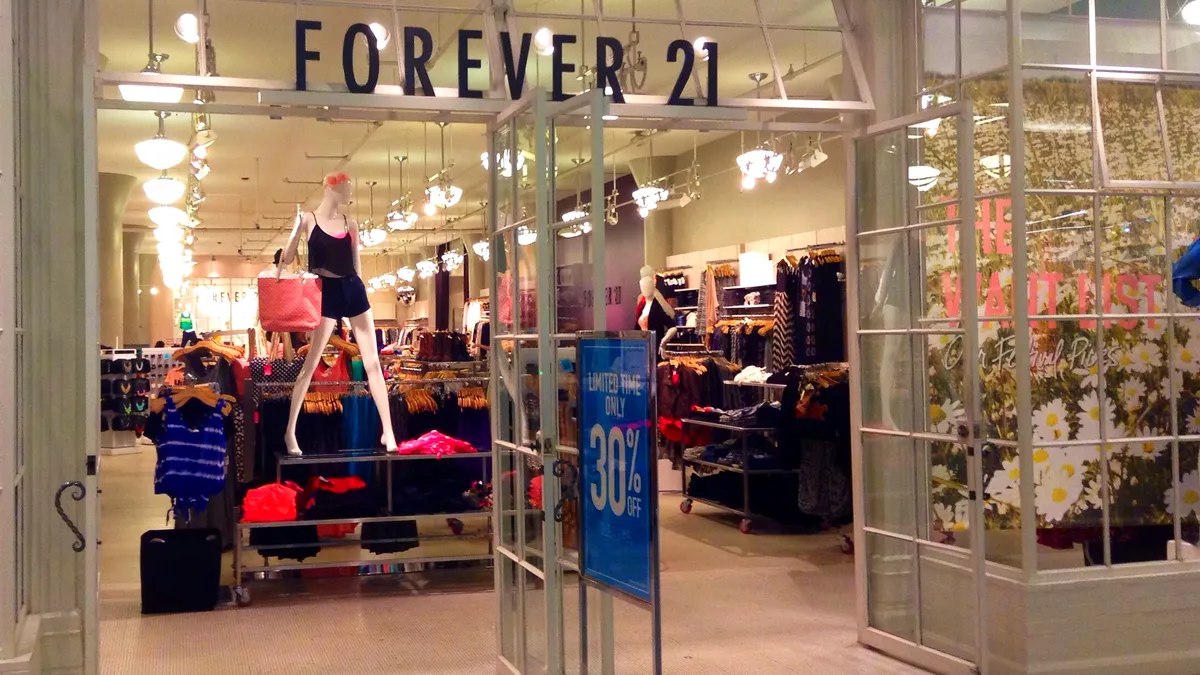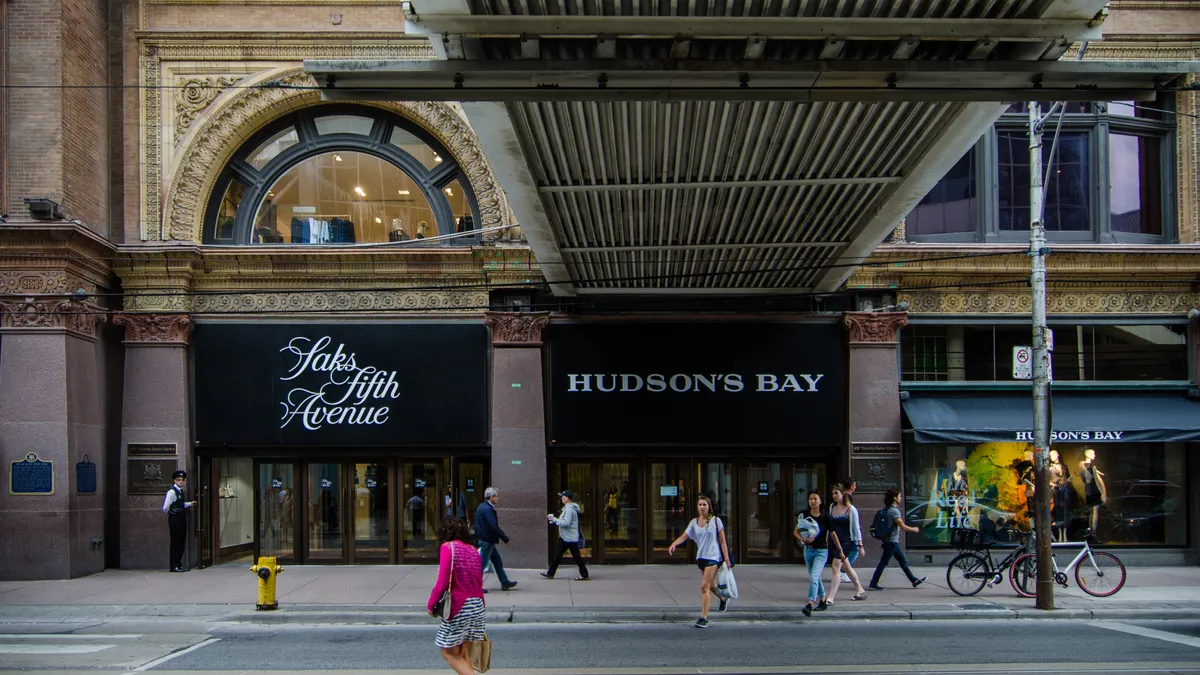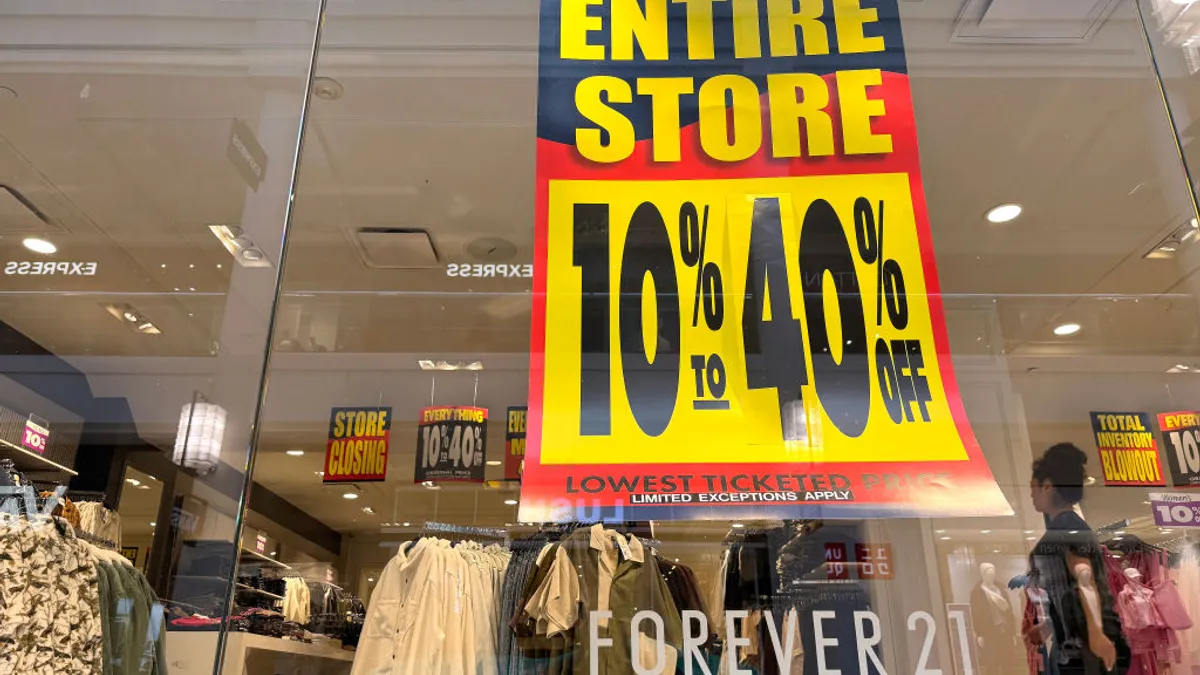In August 2019, a group of small creditors made an appeal to the court overseeing Sears Holdings' bankruptcy.
This was a little less than a year after the company filed its long-anticipated Chapter 11 and several months after the remaining Sears stores were bundled and sold to former CEO Eddie Lampert and his hedge fund. At that point, Sears Holdings was essentially a corporate husk — a party to litigation and the holder of a massive legal bill.
The fees that Sears Holdings owed its lawyers and advisers since filing for Chapter 11 had then reached nearly $170 million. Some creditors, which included some of the department stores' suppliers, argued this likely left Sears Holdings administratively insolvent. They worried the company owed more in administrative claims — including both fees to its advisers as well as payments to vendors and other creditors — than it could possibly pay.
Creditors asked the court to limit how much would be paid out to Sears' hired bankruptcy advisers as a way to balance the interests of lawyers and other professionals with those of other creditors, "who may be staring down the barrel" of big financial losses.
If Chapter 11 expenses are a fire, time and complication are like a heavy wind that can spread them beyond control. There is a hard-to-miss irony to the formidable expenses piled onto a company going through a legal process meant to protect it from financial implosion. Yet for those who file, the expenses are a simple cost of doing business, and potentially well worth it if a retailer is able to shed hundreds of millions of dollars in debt and unprofitable leases, to give it a second chance.
Those expenses for the company are also a major source of profit for others. The costs of bankruptcy aren't limited to the bills from lawyers and restructuring consultants. Finance providers, too, charge exorbitant rates for bankruptcy loans that have been shown to be remarkably safe from payment default. The companies' own executives can also reap windfalls as the retailers they run careen into bankruptcy.
Retail's most expensive bankruptcies
From 2016 through 2020, retailers and their estates have logged about $2 billion on bankruptcy professionals across more than 120 cases, according to Debtwire data provided to Retail Dive. In 2020 — a record year for Chapter 11s in the industry — retail bankruptcy cases racked up more than $500 million in professional expenses.
Since 2016, the most expensive of all was Sears Holdings, whose professional fees and expenses came out just shy of $250 million when all was said and done, according to Debtwire data.
The runner up was another long, tortured retail bankruptcy: Toys R Us, at $207.9 million. The toy retailer filed in 2017 with hopes of a reorganization or sale, but a poor holiday performance led to its ruin in bankruptcy, with lenders opting to liquidate the company's stores months after it filed.
The 20 most expensive retail bankruptcies since 2016
| Company | Total |
|---|---|
| Sears Holdings | $249,496,213 |
| Toys R Us | $207,879,850 |
| Nine West | $104,152,042 |
| J.C. Penney | $61,649,943 |
| Neiman Marcus | $54,435,530 |
| Payless (2019) | $53,783,828 |
| J. Crew | $52,283,469 |
| Claire's Stores | $50,985,014 |
| Tailored Brands | $40,333,505 |
| Centric Brands | $38,175,968 |
| Forever 21 | $38,082,314 |
| Sports Authority | $37,552,085 |
| Ascena Retail Group | $35,693,607 |
| Payless (2017) | $34,720,774 |
| Aeropostale | $34,711,333 |
| Gymboree (2017) | $25,237,048 |
| Gymboree Group (2019) | $24,733,654 |
| Brooks Brothers | $23,890,111 |
| Pier 1 Imports | $22,950,106 |
| Shopko | $22,009,111 |
Those cases were outliers. Even the next most expensive retail bankruptcy, Nine West from 2018, cost more than $100 million less in fees than Toys R Us. On average, retailers spent about $15.5 million in Chapter 11 between 2016 and 2020, according to Retail Dive's analysis of Debtwire data. (Debtwire's data is based on court records, which might not have included all fee applications for the full year of 2020 by the time the data was tabulated.)
That $15.5 million figure is dwarfed by the larger cases, but it's still a hefty cost borne by companies that are in bankruptcy because of liquidity shortages or insolvency. It's also a lot of money exiting companies that are closing stores and laying off employees, who can lose out on severance, pension benefits and the value of company stock options when their employer goes bust.
Retail is only surpassed in total professional fee expenses by the oil and gas industry, which has gone through a huge wave of bankruptcies in recent years. But Josh Friedman, global head of restructuring data at Debtwire, noted that while the oil and gas industry had about 100 more bankruptcy cases than retail and generated more legal costs in aggregate since 2016, retail has been about 40% more expensive on a per-case basis.
"Retail is close to doubly as lucrative as any other sector besides oil and gas over the last few years," Friedman said. "Retail cases tend to run longer, and often culminate in sale processes or liquidations. Often they don't file with a plan in place. They naturally lead to high advisory fees and more expensive bankruptcy processes."
Court records detailing spending on professionals may also underestimate the overall costs to both retailers and other parties in a bankruptcy, according to Lynn LoPucki, a distinguished professor at the University of California, Los Angeles School of Law, who points to some expenses that don't go through the court approval process for various reasons. "There's a lot more money that is spent than shows up in those professional fees," LoPucki said. "Doubling the number for the court awarded fees will give you a rough estimate."
One way retailers can defray those costs is to go into court with a plan that already has the support of lenders. Known as a prepackaged bankruptcy, this can substantially reduce the amount of time — and with it, the expense — spent in court.
"Ultimately, companies want a prepack. We see that with Belk, something fast and crisp to keep down expenses, because they can be astronomical," said Reshmi Basu, restructuring editor with Debtwire, referencing Belk's swift Chapter 11. "Everybody wants a quick stint in bankruptcy if possible, but sometimes you can't."
Yet, even a prepackaged bankruptcy plan doesn't guarantee low costs. Among the most expensive retail bankruptcies in recent history, according to Debtwire's data, are Neiman Marcus, J. Crew, Claire's and Payless' 2017 filing, all of which had lender-supported reorganization plans. Litigation and store closures, one or both of which those cases featured, can add to the costs.
In some cases, the steep costs may even affect the decision of whether to seek Chapter 11. "The fact that the fees are so high prevents some companies that need to file bankruptcy from filing," LoPucki said. Often, when companies head into bankruptcy, they negotiate with lenders for carve-outs from their loans, which designate an amount to cover professional fees. For smaller companies in trouble, their secured debt may be higher than what is covered by the value of their assets, in which case lenders may not agree to the carve-out.
"In the small cases, you see it all the time, where all the assets are encumbered," LoPucki said. "And the debtor goes to the secured creditor and says, 'I need a carve-out; I need to file bankruptcy' and the secured creditor just says 'no.' And that's it."
'Go-to' firms
On the receiving end of all those fees is a cadre of big-name, white-glove law firms, investment banks, restructuring experts, liquidators and other professional service providers.
Chief among them is the law firm Kirkland & Ellis, which has represented Toys R Us, J.C. Penney, Forever 21, Pier 1, Barneys New York, Ascena, Neiman Marcus, Tailored Brands and a host of other major retailers in Chapter 11 cases. Kirkland's name is so associated with retail bankruptcies that it can send shock waves through a retailer's supplier base if news of the law firm's hire gets leaked.
Since 2016, Kirkland fees from retail cases totaled $198.5 million, more than any other professional firm of any type, according to Debtwire data.
(Figures for adviser fees, it's worth noting, are only for work that occurs during a bankruptcy and don't include the weeks or months of preparation and stakeholder negotiation attorneys work on ahead of a filing.)
Top-earning adviser firms in retail bankruptcies
| Advisor | Total |
|---|---|
| Kirkland & Ellis | $198,501,351 |
| Weil Gotshal & Manges | $170,159,498 |
| Alvarez & Marsal | $116,499,379 |
| Lazard Freres & Co. | $110,502,743 |
| Akin Gump Strauss Hauer & Feld | $101,382,976 |
| AlixPartners | $72,408,297 |
| FTI Consulting | $64,093,253 |
| Berkeley Research Group (BRG) | $57,563,301 |
| A&G Realty Partners | $51,525,032 |
| Pachulski Stang Ziehl & Jones | $44,782,037 |
| Houlihan Lokey | $43,261,868 |
| PJT Partners | $39,523,280 |
| Guggenheim Investments | $35,762,363 |
| Cooley | $34,635,509 |
| M-III Partners | $34,341,805 |
| Province | $32,431,381 |
| KPMG | $29,517,793 |
| Paul Weiss Rifkind Wharton & Garrison | $24,715,151 |
| Peter J. Solomon Company | $24,709,056 |
| Ankura Consulting Group | $21,681,358 |
In the industry and restructuring circles, Kirkland is known for its expertise and relationships. "Certain firms become known as go-to firms because they create expertise, knowledge and respect for the work they do, like Kirkland, Weil [Gotshal & Manges] and Skadden," said Scott Stuart, CEO of the Turnaround Management Association. "These are firms that have either been involved with these companies in other aspects, or have built a resume of successful restructurings."
For the retailers that can afford them, Kirkland deploys whole armies of lawyers and other legal professionals to their case. J.C. Penney — which went through excruciating negotiations to sell its operations in bankruptcy, facing possible liquidation if a deal didn't get done — paid more than $21 million to Kirkland between May and September, according to court records. Kirkland declined to comment on this story.
One $9.1 million bill that covered May and June listed a total of more than 9,300 attorney hours spent on Penney's case during the period. Working on Penney's case were roughly 140 Kirkland attorneys, whose fees were anything from a few hundred dollars to more than $1,500 per hour.
In the latter camp was the attorney who often opened for Penney at its hearings, Joshua Sussberg, who has been a lead Kirkland attorney for Toys R Us, Pier 1 and a host of others in the field. Sussberg billed $1,635 an hour for his work at Penney, pulling in more than $564,000 from May through September, according to court records.
And that was just one retail case Sussberg worked on with Kirkland in 2020. He billed another more than $116,000 for his work on the Pier 1 case and $87,000 from Stage Stores, among other cases last year.
In the Toys R Us case from 2017 and 2018, Sussberg billed more than $3 million, by far the most among attorneys on the case with Kirkland, which voluntarily reduced its total fees by more than $1 million. By comparison, a group of 30,000 Toys R Us employees who lost their jobs in the retailer's liquidation were awarded a total $2 million in severance in 2019.
Wasteful? Or money well spent?
The fees that bankrupt retailers pay to their representatives and consultants in a bankruptcy are regulated by the court. That means bankruptcy courts have the ability to limit those fees as too high a toll to pay or improper, though in most cases they are approved. Depending on how you view it, that could mean that the fees are typically fair and in line with what the market will bear, or that they are a sign of a problematic system.
"You really can't understand bankruptcy without understanding that it's a corrupt system," LoPucki said.
Yet bankruptcy, for all its costs, can provide an essential lifeline to struggling companies. Stuart said, "It's easy to go to the default, that bankruptcy is wasteful and expensive. And sometimes it can be, but in most cases it's money well spent to effectuate the best result you can in a bad situation."
Stuart pointed to vendors, manufacturers and employees that could be even harder hit if a distressed situation goes south. "There are so many people in the chain that are affected, that sometimes the cost has to be viewed as a mitigator of the damage," Stuart said. "And I guess at the end of the day, it's almost like a traditional return on investment or a lifetime analysis."
You can also look at it in terms of pure cost-benefit. "Some retailer may file a bankruptcy and discharge $100 million in unsecured debt, and never have to pay that money, ever," LoPucki said. "They just saved $100 million. How much did it cost them? Well, maybe they paid $25 million, $30 million in attorneys fees." In other words, the expenses were well worth the financial benefit of discharging liabilities.
When bringing on advisers to help prepare a filing or restructuring, distressed companies hold a competitive pitch process sometimes with multiple firms, Debtwire's Basu explained, though some private equity owners might have relationships with professional firms that they tap in distressed situations.
When hearing pitches, management's goal is often to keep the company alive as a going concern. "A lot of factors will depend on who's going to take ownership of companies, who could provide the liquidity to keep the company going, how much debt can the company support after it exits bankruptcy," Basu said. "Those are the kinds of questions companies are asking before they file."
Past research by LoPucki found evidence that professionals can overcharge for their work, and that some fees amount to what LoPucki and a co-author called "billing opportunities." Trustees with the Department of Justice review professional charges in federal bankruptcy cases and sometimes object, and judges have the power to limit amounts and payments. But, in LoPucki's view, nobody has incentive to rein in the fees.
Judges, LoPucki argues, are incentivized to be friendly to debtors' lawyers. With a federal bankruptcy system that lets attorneys choose where to file cases, attorneys can pick the courts that are friendliest to their aims. "The courts compete to get the cases, and they compete to get the cases by looking the other way on all kinds of stuff, by giving all kinds of advantages that they can't legitimately give," LoPucki said. "The honest judges won't do this. And so they just don't get any cases. The cases jump around the country, to the judges who are willing to do it."
"You really can't understand bankruptcy without understanding that it's a corrupt system."

Lynn LoPucki
Professor, University of California, Los Angeles School of Law
If true, that would create a virtuous cycle for the most powerful bankruptcy practices, which can reward friendly judges with cases for their docket — which boosts the prestige and workload for the judge's court and the local bar — and then attract new clients who see the favorable outcomes in past cases.
LoPucki and colleagues have created an online research tool that can show to which courts bankruptcy cases migrate. To take the retail bankruptcy superstars Kirkland & Ellis as an example, the data shows that of nearly 50 bankruptcy cases Kirkland has filed since 2016, more than half have gone to just two judges at the Southern District of Texas, the court that handled the Chapter 11s of J.C. Penney, Neiman Marcus and other retailers.
Among all the other outcomes of a bankruptcy it could impact, court shopping could help smooth approval of attorney fees. Even so, that doesn't mean that bankruptcy professionals are necessarily over charging their clients, at least not any more so than lawyers and advisers do on other types of cases.
"Are they exorbitant? Yes," David Farrell, a partner with law firm Thompson Coburn, said of bankruptcy attorney fees. "But what do you think lawyers are charging for mergers and acquisitions? I mean, it's the same outrageous rate — legal fees are just high. [Bankruptcy] is just as sophisticated, if not more so, and higher pressure."
"It seems a little unfair to say, well, in the bankruptcy context, we're going to cut your fees because there's a court involved, and court-scrutinized professional fees. Whereas outside of court, you can go ahead and charge" whatever fees a firm chooses, Farrell added. "All that does is just provide a disincentive for sophisticated counsel to get involved in, and for large firms to have, bankruptcy practices."
The mayday payday
In July 2017, roughly two months before Toys R Us filed for bankruptcy, then-CEO Dave Brandon sent an email to his chief talent officer explaining that they had to "deal with a reality," and be "creative and design something that works for us."
The "reality" he referred to was that executive compensation, both salaries and bonuses for running the struggling toy store chain, exceeded market rates. "Outside stats and comparisons are not going to help us," Brandon wrote, referring to devising compensation for himself and his team.
Shortly later, attorneys with Kirkland & Ellis advised Brandon that bonuses to the executive team in the company's pending bankruptcy would be "subject to stringent bankruptcy rules and much greater scrutiny" and would have to be "incentive-based and 'reasonable'" compared to market rates. All of this is according to communication unearthed in litigation by former Toys R Us creditors against Brandon and other executives and board members.
Brandon and the chief talent officer, Tim Grace, resolved the court scrutiny conundrum by paying out retention bonuses — including $2.8 million to Brandon — in September, mere days before Toys R Us filed for Chapter 11. By doing so, the company could pay out retention bonuses with no performance targets before the payments were subject to court oversight.
The bonuses, along with other insider payouts, were the subject of a lawsuit from former creditors who lost many millions of dollars when Toys R Us tipped suddenly into liquidation. The lawsuit — filed originally in March last year and still being litigated in federal bankruptcy court in Virginia — didn't stop other retailers bound for bankruptcy in 2020 from paying retention bonuses to executives.
In May, J.C. Penney paid out more than $10 million in retention bonuses to top managers of the company just days before the company filed. That included more than $4 million to then-CEO Jill Soltau, who left the company a few months later, after its acquisition.
GNC, Neiman Marcus, Ascena Retail Group, Tailored Brands and Tuesday Morning also all disclosed that they paid millions of dollars in retention bonuses to executives in the weeks or days before filing for bankruptcy.
"Worst case, you might have to give some of it back, but probably not all of it. And you might get away with getting to keep all of it."

David Farrell
Partner, Thompson Coburn
The executive payouts — ostensibly to keep executives from jumping ship at a very delicate and critical time — are becoming so routine they are essentially an added cost of filing for bankruptcy. "Another big drain now, is these retention bonuses that get paid to top managers when they're about to file bankruptcy," LoPucki said. "The top managers pay themselves a big bonus. And it's improper, but nobody ever comes after them."
In the 2000s, "Congress went through these elaborate efforts to try to rein in all these bonuses that were being awarded by bankruptcy courts," Farrell said. Changes to the bankruptcy code from the time included tying executive bonuses while in bankruptcy to certain performance goals rather than mere retention.
"Particularly over the last year or so, petitioners just said, 'Well screw it, we'll just completely circumvent the system and pay the bonuses before we file bankruptcy, and then when they don't get scrutinized at all by a court, we don't have to worry about it,'" Farrell said.
Under provisions in the bankruptcy code around fraudulent transfers, it's at least theoretically possible for some parties, such as unsecured creditors, to claw the bonuses back. To do so, though, Farrell explained, means proving that the bonuses exceeded the value of whatever the company received in exchange.
"That's a hard case to make in these situations," Farrell said. "Certainly the executives will come in and say, 'Well, I had lots of opportunities, I could have left, I stuck around and benefited the company.' All that has to be litigated after the fact. And it's expensive."
At the end of the day, the risk of clawback might not matter very much to management, according to Farrell, who described the bonuses as a "payday before mayday" in the legal publication JD Supra.
"From the executive standpoint, it's kind of like, that's the worst thing that's going to happen to you? Okay, give yourself some bonuses. Worst case, you might have to give some of it back, but probably not all of it. And you might get away with getting to keep all of it," Farrell said. "So what's the downside? I mean, there's reputation and the public scrutiny that comes with this. But that doesn't seem to be a big inhibition [for] any of the executives so far."
Extractive loans
There's another group that can profit when retailers go bankrupt: lenders.
For retailers in bankruptcy, financing is key to a smooth process, especially if the company is working toward a reorganization or sale. If a company can't pay its employees and keep the lights on, the remaining value of assets can be extinguished, causing all kinds of harm to numerous stakeholders.
In retail bankruptcies, that financing typically takes the form of a debtor-in-possession (DIP) loan or other debt instrument, and they are often provided by a company's existing secured lenders.
Research has found that DIPs are priced far beyond what they would be in a normal competitive market. A recent paper exploring DIP pricing, which is a followup to a 2019 paper and still under review for publication, found that out of 392 DIP loans from the years 2002 to 2014, every single one was repaid in full. The risk to lenders was effectively zero. The findings echo previous research by Moody's that found DIPs to be overwhelmingly repaid by borrowers.
The safety of DIP loans stems from them being secured by a company's assets. In a retailer's case, that is almost always its inventory, which can be sold in store closure sales if a company can't reorganize or find a buyer. DIPs are also highly monitored and require regular financial disclosures to lenders, who in turn get early warning signs of problems and are well-protected through stipulations and milestones in the loan terms.
"You have to understand one thing, the debtor is extremely happy to get the loan. ... Its survival is on the line. So they are in an extremely weak bargaining position."

B. Espen Eckbo
Tuck Centennial Professor of finance, Dartmouth College
In terms of payment default, DIP loans are as safe as the investment-grade loans that get A-level ratings from agencies like Moody's. Yet, on average, DIP borrowers pay interest rates five times larger than borrowers on investment-grade loans, according to the 2020 paper.
The authors found that the average DIP loan was priced on average at 6% above LIBOR, a common baseline for loans. According to Debtwire's Friedman, retail companies in bankruptcy have paid an average interest rate between 8% and 8.5% on DIP financing over the past five years (a figure that includes LIBOR and base rates in it).
The paper's authors point to what they call an "agency problem" with the CEOs of company's filing for bankruptcy. "You have to understand one thing, the debtor is extremely happy to get the loan," B. Espen Eckbo, Tuck Centennial Professor of finance at Dartmouth College's business school and one of the paper's authors, said in an interview. "Its survival is on the line. So they are in an extremely weak bargaining position."
Negotiating the loan terms on behalf of the companies are executives, who have interests that diverge from other stakeholders such as suppliers, landlords and junior creditors, all of whom might be the ones hurt by an exorbitantly priced loan.
"The CEO wants to preserve his or her career going forward after bankruptcy. And the CEO doesn't pay the bill, right?" Eckbo said. "So… they may be too weak of a bargaining partner." Moreover, executives may be wary of holding an auction among prospective lenders for fear of news of an imminent bankruptcy leaking, which could set off a panic among suppliers.
As with professional fees, DIP terms are regulated by courts. Eckbo and his colleagues found that there were objections to DIP terms in 60% of the cases they researched, but courts "routinely approve generous DIP-loan terms," which "raises concerns about judicial oversight," the authors wrote in their paper.
The high prices pegged to fundamentally safe loans are explained by what the authors call "rent extraction" among lenders to bankrupt companies. In layman's terms, you could call it profiteering.
Eckbo said that there could also be a "psychological" element to DIP pricing. "There's a lot of people scared of this or that, perhaps," he said. "And so they falsely judge the risk, though the contracts are so watertight and successful."
Even in cases where retailers wind down, DIP lenders generally get repaid thanks to their asset liens. The executives who sign deals for exorbitantly priced loans, which can help pay for expensive consultants and lawyers to help with the case, are also often paying themselves large bonuses ahead of a filing.
Other stakeholders down the chain don't come out so well. Sears suppliers were paid pennies on the dollar, while the retailer closed hundreds of stores in Chapter 11. In the Toys R Us case, scores of suppliers lost hundreds of millions of dollars, and 30,000 employees — some of whom had been with the toy retailer for decades — lost their jobs.
In other words, lenders, hired professionals and executives can come out of a bankruptcy situation millions of dollars richer for it. Meanwhile, those without liens on assets, legal priority or economic leverage have been the losers in many of the most expensive retail bankruptcies.




















